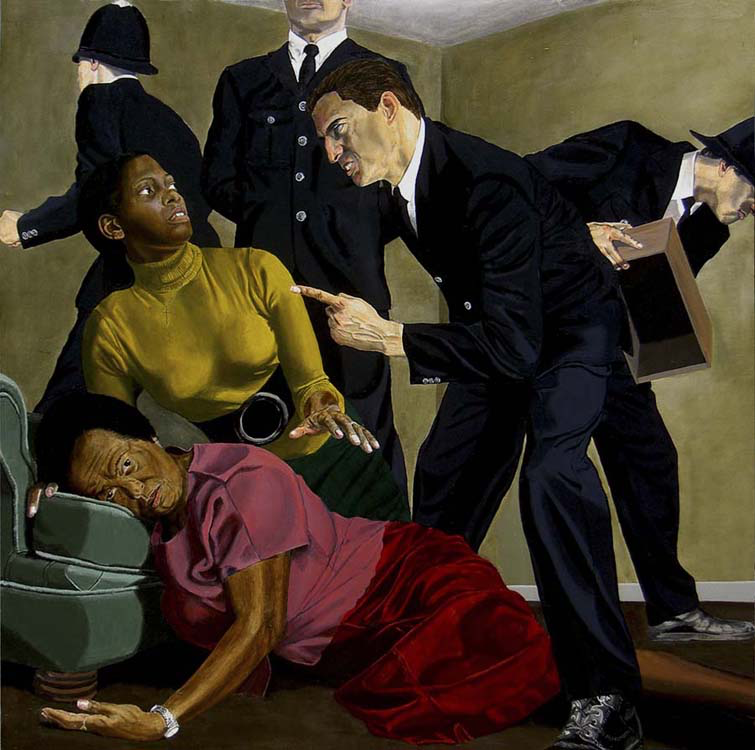
LONDON — This August marked the 10th anniversary of the killing of Mark Duggan by the Metropolitan Police, an event that sparked widespread uprisings, characterized as riots, across Britain in the summer of 2011. This unrest was not isolated or simply a reaction to the austerity measures implemented by the UK government following the financial crash of 2008, but the latest event in a lineage of struggle. War Inna Babylon: The Community’s Struggle For Truth and Rights at the Institute of Contemporary Arts (ICA) charts a journey of community resistance to state oppression that Black people have been subjected to ever since African Caribbean people began arriving in England in significant numbers in the late 1940s.
This carefully curated exhibition lays bare the insidious nature of the subjugation of Black people in Britain on all fronts — not only by police violence but in employment, housing, education, politics — the list goes on. On this anniversary, while many still misunderstand and sensationalize the events of 2011, the curatorial team, made up of racial justice organization Tottenham Rights and independent curators Rianna Jade Parker and Kamara Scott, takes the audience on a historical journey that contextualizes not only those uprisings but the ones that it echoed from 30 years prior — Brixton, Handsworth, Toxteth.

“How can you go around troubling people all your life and expect nothing to come back?” asks a young woman in The People’s Account (1985), a documentary by the Ceddo Film and Video Workshop, screened here alongside three films by one of the collective’s founders, Menelik Shabazz, including the incandescent Blood Ah Go Run (1981). The latter documents the aftermath of the New Cross Fire, where 13 Black teenagers were killed in an arson attack, but it is The People’s Account which is damning in its incisive presentation of the police’s failures during the Broadwater Farm uprisings in 1984. Shabazz’s presence is felt throughout, a fact that is bittersweet, as the filmmaker passed away just days before the ICA show’s opening. Visitors are invited to open the central display cabinet in the main gallery that guards his prescient quote from a 1986 interview: “By documenting events as we are doing, it’s laying a tradition and providing an alternative to what has been portrayed in the media. Which has been blatantly racist.”

At its inception, War Inna Babylon focused on “The Killing of Mark Duggan,”a digital reconstruction of the scene of his death by the acclaimed research collective Forensic Architecture. Tottenham Rights, Parker, and Scott came on board to broaden the scope beyond this single, seismic case that is still reverberating a decade later. In May of this year, the Independent Office for Police Conduct announced that the investigation would not be reopened. In the video installation “The Five Families of Tottenham,” family members, including Duggan’s mother, pay tribute to those who died in police custody. The collective grief is quietly devastating. Beyond the campaigns, beyond the investigations, beyond the press coverage, what is left is profound loss.

The exhibition also includes several paintings and photographs. Parker explains that including “cultural productions of Black Britons and their creative documentation reflecting the times was as necessary as legal and academic evidence.” Vanley Burke’s documentary photography is synonymous with Black British history, though his works shown here, of the crowds gathered at African Liberation Day, which took place in Birmingham in 1977, alongside Janine Wiedel’s photographs of the Anti-Apartheid protest in 1985 in London, highlight the fact that Black resistance has always had a global outlook.

If Burke’s images tell a story of collective power, Kimathi Donkor’s oil paintings capture the moments of terror when the violent power of the state descends on an individual. In “Under Fire: The Death of Cherry Groce” (2005), the intense contrast between the dark, shadowy background and the flash of the fired gun illuminates Groce in the final moment before her life was taken by the officer wielding the weapon. “Madonna Metropolitan: The Death of Cynthia Jarrett” (2005) evokes classical biblical paintings such as Carraci’s “The Dead Christ Mourned,” except instead of the three Marys, menacing police officers surround Jarrett and her daughter. But this is not an allegory; in the upstairs gallery, Jarrett’s son gives a testimony along with the other family members who have lost loved ones to police violence. Deeply uncomfortable and haunting, these works lingered in my mind long after I had left.
Often there is a sense that Black people should be grateful for the opportunity to take up space in a prestigious public institution, but the generosity here is from the curators, in the thoroughness and sensitivity given to this urgent subject. Many items exhibited come from their personal archives. Although this is not the first of its kind — Us an’ Dem was a 1994 exhibition curated by Eddie Chambers looking at the relationship between the police and the Black community — War Inna Babylon is careful and intentional in conveying the importance of being informed by the past while being rooted in action, in the urgency of the present moment.
War Inna Babylon: The Community’s Struggle For Truth and Rights continues at the ICA London (the Mall, St. James’s, London) through September 26.
0 Commentaires